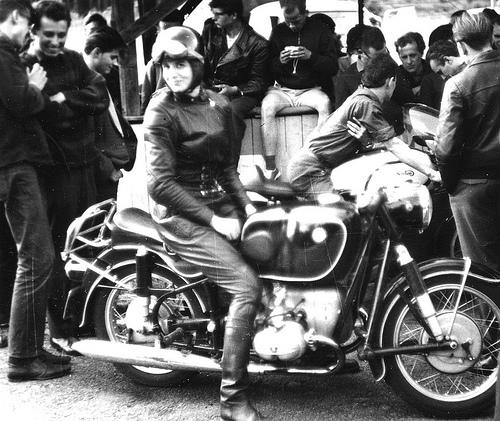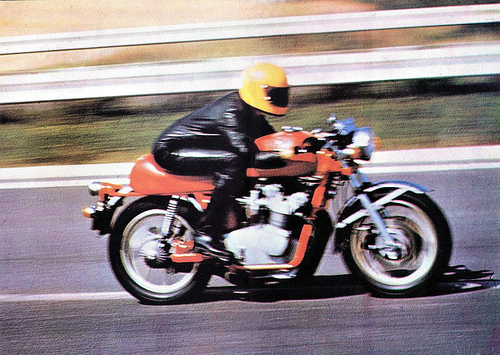
By vanishing from view in the mid-1970s, after 20 years of being very much in the public eye as an internationally published journalist, Anke-Eve became a cypher, because a beguiling woman riding a motorcycle in the 1950s remains extraordinary. Her real life story was almost forgotten, as those who knew her best have mostly died, and AEG herself, born in 1929, is not long for this world (if indeed she’s still alive). The chance to interview her directly has passed. But…The Vintagent corresponded with and eventually interviewed her ex-husband Hans in 2012, after Anke-Eve, through her daughter, made it clear she wanted no part of a biography. She was too upset that the Internet had exploited her image for ‘pornography’, as she put it. Then again, even Hans admitted,
“She was devastating on a motorcycle.”
Anke Eve’s ten years of writing for motorcycle magazines has survived. The Vintagent has already republished her article on the women’s motorcycle racing series in the Soviet Union, originally published in Cycle World in 1962 [‘Soviet Racing Women’]. She wrote regularly for Moto Nytt in Sweden, Motorrad in Germany, Moto Revue in France, Motociclismo in Spain, Auto-Moto in Hungary, and even Japanese magazines. She corresponded with women riders everywhere, and was instrumental in founding WIMA (the Women’s International Motorcyclist Association) in Europe, and was their press officer for many years. She wasn’t anonymous, just the opposite; she was a famous figure in her day, although as a woman she faced considerable opposition – first at home, then in the German motorcycle community, then with racing organizations, and ultimately with patriarchy, which constrained her activities while exploiting her image.

To clarify a few questions usually asked about her: she wasn’t Jewish, despite the Goldmann name. She was born in Berlin in 1929, and after the war took a job teaching German at a US Air Force school near Dortmund, where her family had moved when Berlin became uninhabitable. She spoke good English, with an American accent. She first started riding motorcycles in 1953, on a BMW R67/3, trading it in on what is believed to be the second production BMW R69 built, in 1955. This period saw her full commitment to motorcycling; racing in the UK, organizing WIMA Europe, gaining recognition from BMW as a brand ambassador, writing articles for magazines, and working with German riding gear manufacturer Harro to build riding suits to her design. Her distinctive racing suit used a diagonal zipper across the chest for easy entry, and was form-fitting for style and wind resistance. Harro presumably also built her heavy winter riding gear, kidney belts, and other accessories she’s photographed with…also presumably these were one-offs, as no other women wore such gear in the 1950s, and very few people rode their motorcycles in the snow! She was an avid fan of the mid-winter Elephant Rally in Germany.

It was the end of an era for AEG when BMW introduced the R75/5 in 1970. She bought an early example, but thought it ugly, calling it a ‘Hyena’. She felt it was no competition for other sporting motorcycles on the market, like the Honda CB750 and Norton Commando, and so she looked elsewhere – to Italy, actually. In late 1970, at age 40, she purchased an MV Agusta 750 Sport, perhaps the only woman to buy such a machine new. She loved the handling, and the power, and the noise, and the looks. In 1973 she commissioned a fully race-tuned MV 750 Super Sports with an overbored engine, larger carbs, and open megaphones, that produced over 100hp. It was the first motorcycle in Germany road-registered with magnesium wheels and triple disc brakes; it was an awesome machine, utterly gorgeous, and one of the finest cafe racers ever built. Hans laments she never raced the hot MV, because
“a motivated Anke-Eve riding the MV Agusta on a race track would have been a tremendous experience”
After a dear friend was killed on his MV Agusta in the mid-1970s, AEG gave up motorcycling. She traveled considerably, in Asia especially, and usually solo. Over time, her story was forgotten, until an image-hungry Internet raised her profile again, and The Vintagent ferreted out her identity and her story, which will be told in full when the stars align. She was a pioneer of women in love with speed, and a feminist hero, working for the recognition of women in her chosen domain of motorcycling. In her youth she facing jeers for her riding and racing, was called horrible names by the public and kicked out of her home, but carried on regardless, ultimately changing how people think about women on wheels.

Related Posts
July 8, 2017
The Vintagent Trailers: Mancini, The Motorcycle Wizard
The mechanic that helped debut five of…




Great story about a wonderful lady!
Fascinating! Thanx to I&R for tipping me off to your site, Paul. Enjoy everything you bring to both motorcycling and to life!
Wonderful story here paul!
What a wonderful story, great pictures.
muy buena historia sobre Anke, historiadora y corredor de motos
Saw photos of AEG & her R69 in “Ton Up!” and, as an old BMW rider, was intrigued. Google led me to “The Vintagent”. All-in-all, a win! Thanks.
Now 2023 and this wonderful Lady is, I believe, still alive ! Hopefully she can add more to her inspiring life on motorcycles. She was THE original Lady biker 🙂
I reached out to her via her daughter in 2010, hoping for an interview and a possible book, but she firmly denied any interest in cooperating on such a project. I have the rights to her husband’s photos from the 1950s/60s, which are used in the article, and I interviewed him extensively for the story. I wish AEG would also consent for an interview: she is an amazing woman. And also very stubborn!